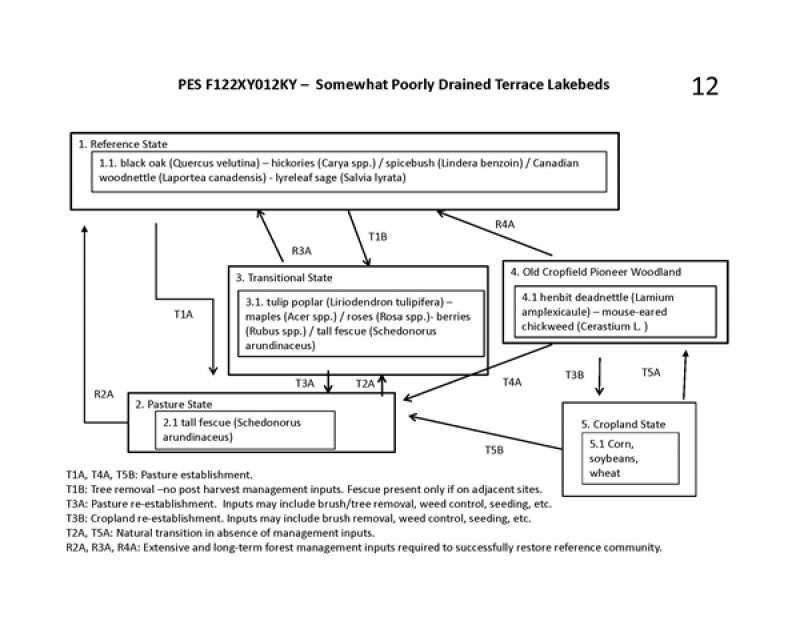
Natural Resources
Conservation Service
Ecological site F122XY012KY
Somewhat Poorly Drained Terrace Lakebeds
Last updated: 5/14/2025
Accessed: 12/20/2025
General information
Provisional. A provisional ecological site description has undergone quality control and quality assurance review. It contains a working state and transition model and enough information to identify the ecological site.
MLRA notes
Major Land Resource Area (MLRA): 122X–Highland Rim and Pennyroyal
MLRA 122 is in Tennessee (47 percent), Kentucky (43 percent), Indiana (7 percent), and Alabama (3 percent). It makes up about 21,530 square miles (55,790 square kilometers).
SOILS:
Many of the soils in this MLRA are Udalfs. The moderately deep to very deep, well drained, clayey soils formed in limestone residuum. They are dominantly in rolling to steep areas of the “Outer Basin” (Mimosa, Braxton, Gladdice, and Hampshire series) and the undulating to hilly areas of the “Inner Basin” (Talbott and Bradyville series). The most agriculturally productive soils are the very deep, well drained, clayey or loamy soils that formed in alluvium and/or loess over alluvium or limestone residuum in nearly level to undulating areas (Armour, Cumberland, Harpeth, Lomond, and Maury series). The less extensive soils generally are moderately well drained to somewhat poorly drained and formed in loamy or clayey alluvium and/or residuum (Byler, Capshaw, Colbert, and Tupelo series). This MLRA has a significant acreage of Mollisols. Shallow or moderately deep, well drained, clayey Udolls (Ashwood and Barfield series) formed in limestone residuum dominantly in rolling to steep areas. Very shallow, well drained, clayey Rendolls (Gladeville series) formed in limestone residuum dominantly in undulating to rolling areas of the “Inner Basin.” Very deep, well drained or moderately well drained Udolls (Arrington, Egam, Lynnville, and Staser series) and somewhat poorly drained or poorly drained Aquolls (Agee, Godwin, and Lanton series) formed in loamy or clayey alluvium derived from limestone on flood plains. Most of the remaining soils on flood plains are moderately well drained or well drained Udepts (Lindell and Ocana series). Udults are of small extent in this area. Most are very deep, well drained, and loamy and formed in gravelly colluvium or colluvium and the underlying residuum on steep hillsides (Dellrose soils). Rock outcrops are common on uplands.
BIOLOGICAL RESOURCES:
This area supports mixed oak forest vegetation. White oak, black oak, northern red oak, and some scarlet oak are the dominant tree species. Shagbark hickory, bitternut hickory, pignut hickory, and mockernut hickory also occur. Oak, blackgum, flowering dogwood, sassafras, Virginia pine, pitch pine, and shortleaf pine grow mostly on ridgetops.
(Excerpt from United States Department of Agriculture, Natural Resources Conservation Service. 2006. Land Resource Regions and Major Land Resource Areas of the United States, the Caribbean, and the Pacific Basin. U.S. Department of Agriculture Handbook 296.)
Classification relationships
Scientific Name: South-Central Interior Large Floodplain Unique Identifier: CES202.705
Possible Association(s):
Platanus occidentalis - Liquidambar styraciflua / Carpinus caroliniana - Asimina triloba Forest
Translated Name: American Sycamore - Sweetgum / American Hornbeam - Pawpaw Forest
Common Name: Sycamore - Sweetgum Streambottom Forest
Unique Identifier: CEGL007340
Classification Approach: International Vegetation Classification (IVC)
Ecological site concept
This PES describes plant communities likely to be found on these soils but does not encompass the entire complexity or diversity potential of these sites. Future field work is required to delineate and develop a full ecological site description (ESD) which can be utilized for conservation and planning purposes.
State 1, Phase 1.1:
pin oak (Quercus palustris) – sweetgum (Liquidambar styraciflua) / spicebush (Lindera benzoin) / Canadian woodnettle (Laportea canadensis) - lyreleaf sage (Salvia lyrata)
Trees found on these sites according to the NASIS database: pin oak, sweetgum, sycamore, tuliptree, green ash, hackberry, “hybrid hickory”, red maple, shellbark hickory, and white ash.
Most of these sites in MLRA 122 are cropland, pasture, urban, or successional woodlands; therefore, the exact characteristics of a true historic reference community is difficult to accurately define. Field studies would be required to develop a restoration plan for conservation purposes.
State: 2. Pasture
State 2, Phase 2.1: Managed Pasture. Plant species dominants: usually Schedonorus arundinaceus (tall fescue). Pasture vegetation depends on seeding and management.
State: 3 – Transitional (Abandoned) Field
State 3, Phases 3.1: tulip poplar (Liriodendron tulipifera) – maples (Acer spp.) / roses (Rosa spp.)- berries (Rubus spp.) / tall fescue (Schedonorus arundinaceus)
Tree species regeneration on these sites will depend on the severity and duration of disturbance, soil characteristics, adjacent plant communities and seed sources, post-disturbance management inputs, presence or absence of continued site disturbances (grazing), slope, and aspect.
State 4: Phase 4.1. Abandoned Cropland
Common plant species dominant:
henbit deadnettle (Lamium amplexicaule) – mouse-eared chickweed (Cerastium L. )
State 5: Phase 5.1. Cropland
Plant species dominants: Zea spp. – Glycine spp.
Plants on these sites will be dependent upon seeding and management. Most common crops are corn and soybeans. Due to the drainage issues on these soil, many have been tiled extensively to facilitate crop production.
Transitioning to a reference condition will require extensive timber stand improvement practices, hydrological restoration, and weed control.
Similar sites
| F122XY011KY |
Somewhat Poorly Drained Fragipan Terraces And Uplands – Somewhat Poorly Drained Fragipan Terraces and Uplands |
|---|
Table 1. Dominant plant species
| Tree |
(1) Quercus velutina |
|---|---|
| Shrub |
(1) Lindera benzoin |
| Herbaceous |
(1) Laportea canadensis |
Click on box and path labels to scroll to the respective text.
